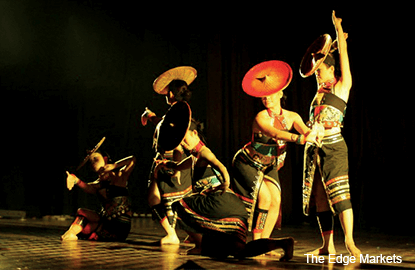
This article first appeared in The Edge Financial Daily, on December 29, 2015.

Walking into the large rehearsal space on a late Wednesday evening, a group of dancers were in the midst of rehearsing Undercurrent (2010), the piece that took the Gold Prize, Best Costume, and Best Choreography award at the 22nd National Chinese Dance Festival.
It wasn’t the kind of ‘Chinese dance’ we’re accustomed to watching on television or seeing at shopping mall performances. Dressed in black pantsuits, the dancers inhaled collectively and tumbled gracefully in a series of fast movements, as choreographer Justin Wong Cheong Chee, 56, silently looked on from a distance.
The modern dance piece is perhaps the most personal for the choreographer, inspired by a real life incident of his that depicts people on the verge of an emotional collapse. As I am told later, this is Chinese dance, but the difference from what we’re used to seeing is the depth that comes from years of study and exploration.
The Han Fong Dance Ensemble, a non-profit dance group, will be presenting Dance. In Retrospect, an upcoming performance featuring works from Wong’s three decades as a choreographer. Each of the 16-selected dances are award-winning works.

Wong admits it was incredibly difficult to select the dances for this showcase at the Kuala Lumpur Performing Arts Centre (klPac). “Besides the best works, we also tried to choose dances with different styles, to showcase a variety — contemporary, ethnic, classical, so on and so forth,” he explains. “Of course, I picked a few more than we planned to, I couldn’t resist,” he adds, laughingly.
Born in the small town of Tronoh, Perak, Wong grew up interested in dance but never had an opportunity to try it out. “It was very, very small. The town was just two streets. We never had these kinds of activities, but I grew up watching Chinese Opera, which was common there,” says Wong.
When he came up to Kuala Lumpur to work — his job experiences included being a cook, fridge repair and jewellery-making apprentice, and a dance costume-maker — friends introduced him to ballet, and at age of 20, Wong took his first class under Lee Lian Yew. He encountered Chinese dance in 1983, and upon realising he had a flair for it and learnt quickly, Wong pursued it, eventually teaching and choreographing full-time, with a stint of training in China.
Featuring over 20 dancers of various ages, the dances to be showcased include a traditional ethnic piece inspired by Yunnan’s Dai tribe, a silk-road inspired work drawn from Dunhuang’s Mogao Grotto murals and carvings, a classical court dance drawing from Han and Tang dynasty, a contemporary piece using silk fans, and even a piece incorporating traditional Korean dance elements, portraying the falling leaves of autumn. One of the two medleys performed will also feature a Southeast Asian theme, paying homage to the Nanyang region.
The dances are enhanced by detailed costumes, designed and sewn by the ensemble’s costume designer Kevin Chan, 57. “I researched each dance genre, especially the cultural ones, and copied the details, but of course, I made it more danceable and prettier when they move,” describes Chan.
Wong says that Chinese dance is just a general label, but their programme highlights the breadth of dances the genre actually encompasses. Chan chips in, “We’re used to seeing only a very small bit and superficial style of Chinese dance, like with the (hand) fans, and shaking it around.” Wong agrees, “There are so many types of dances, from different cultures and areas, where their unique qualities are embedded in the dance’s style.”
Describing the movement’s essence as fluid and unbroken, dancer Anjoey Chong, 28, agrees with her teacher, recalling that when she first joined three years ago, she found the dance form more structured and mature than expected.
Chan further points out, “It can also be a very abstract and imaginative genre. That’s why we don’t need props, we can just use a simple cloth as wind, or clouds, or even water. Or use the body.”
Wong exemplifies this with a work that pays tribute to Chinese Opera, Painted Faces (2014), where he borrowed an opera storyline but presents it in a classical dance style. “The movements tell the story,” he says.
The artistic director concedes that it’s inevitable that there is an outdated perception when it comes to Chinese dance, but insists that it is because of the stereotyping and limited exposure. Given the unique identity of the Malaysian Chinese people, Wong says it is even more important to go back to the roots to know themselves.
That is his answer to having depth, drawing a parallel to dance, “In Chinese dance, you have to revisit where we come from, to make sure we learn the original, foundational form, then only we can evolve and innovate from there. If you don’t have foundational roots, you cannot move forward to create new things.”
Dance. In Retrospect will be performed from Jan 1 to 3 at Pentas 1, klPac, Jalan Strachan, off Jalan Ipoh, Kuala Lumpur. Tickets are RM68 and RM48, to purchase or to find out more visit www.klpac.org or call (03) 4047 9000.